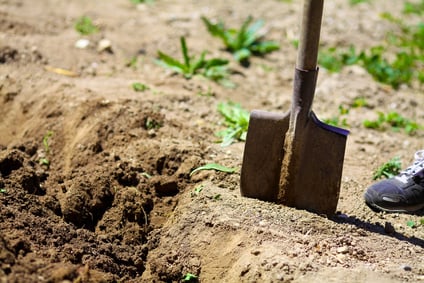Simple digging methods for soil preparation

If you are cultivating by hand, rather than using a mechanical rotavator, tiller or cultivator, there are a couple of methods you can use.
1. Simple Dig and Drop. The simplest method of turning the soil over ready for the growing season, considered by some to be too simple, but often this and careful composting is all a plot needs.
It involves simply digging up a large clod or chunk of earth, either turning it over and dumping it or putting it down, breaking up the earth in the hole you created and then popping the clod back, breaking that up after returning it. This works for some people, without the complexities of trenches and so on, but you have to be methodical about where you are digging.
2. Single Digging. Like the dig and drop, this involves simply turning over the soil to the depth of your spade or fork. However, this method is more organised and structured.
Dig a smallish trench, perhaps about a foot or so wide (30 or more centimetres) and the depth of your spade or shovel, all along the length of your plot. Drop the soil from this trench aside, or in a container or wheelbarrow, so the trench remains empty. Then dig the same amount of soil from the same sized area next to it, tipping the soil, upside down, into the original tench and creating another. When you reach the end, the soil from the final trench goes back into the original trench (A tip – Deposit it in the barrow when you dig it out and wheel it back around to the original trench.)*
3. Double Digging. Only really applicable in Autumn or winter or when you are starting a new plot from scratch or when you need to enrich and deepen your topsoil or increase drainage
Double digging, as the name suggests is, in essence, very like single digging (see above) but involves loosening two spade depths of soil from the trench, keeping the two loads separate then dropping one load back in turned over, followed by compost and manure, then the other load turned over.
*Alternatively, you can divide the plot into two large strips, either in your head or with canes and string and work up and down so you end up filling in the final trench with the soil from the end of the last strip.